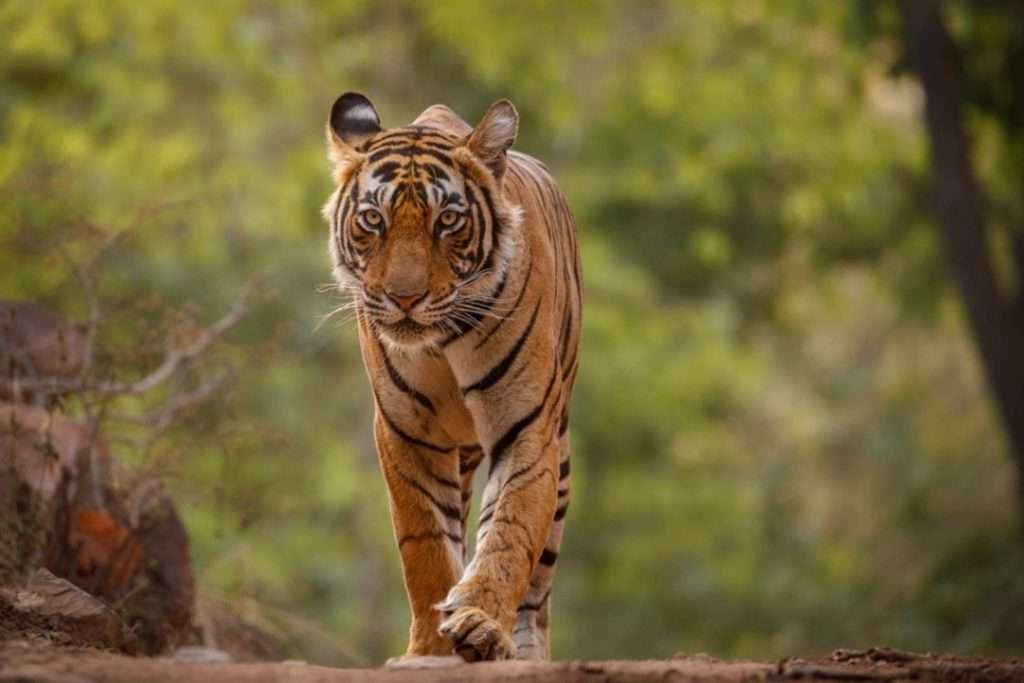The tiger animal is one of the most powerful predators, living in forests and preying on animals weaker than itself. Below, I’ll delve into more details about tigers, describing their lifestyle, habitat, reproduction, and cub care.
In this article in TekeTrek Website, we will introduce you to the most important information related to this object. Follow along with us.

Information about the tiger animals
Tigers are mammals and belong to the cat family (Felidae). The power is Trait of tiger but What is the description of a tiger?
- They inhabit the wild and typically live for an average of 8 to 10 years.
- Their body length usually ranges from 1.25 to 2.5 meters, with tail lengths varying from 60 to 110 centimeters.
- Tigers’ weight varies significantly, ranging from 40 to 300 kilograms. Females are generally lighter than males.
- Identifying Tigers are easily recognizable by their reddish-orange coat with dark stripes.
- They are the largest wild cats globally, rivaled only by lions in strength and ferocity.
Reproduction in Tigers
- Tigers reproduce through live birth, with females giving birth to litters of three or four cubs
- The mother cares for her cubs until they are about 1.5 years old.
- During the first month, the mother’s size increases fourfold due to milk production.
- Female tigers signal their readiness to mate through scent marking, and there is no specific breeding season. However, mating often occurs during winter.
- After a gestation period of over three months, the striped cubs are born.
- Newborn tiger cubs weigh ranges between 1.0 to 1.5 kg and it’s length ranges between 30 to 40 cm.
- Initially, their bodies are slender and weak, but they rapidly grow due to maternal care and nourishment.
- Tiger cubs are born blind, and even when their eyes open, they have limited vision for six to eight weeks.
- A prolonged period of nursing, care, and training follows. During this time, cub mortality rates can be high, especially if food is scarce.
- Weaker cubs receive less food due to the aggression of stronger siblings. Cubs stay with their mother until around their second year, when they approach maturity and can hunt on their own.

Tiger Lifestyle
- The tiger animals led solitary lives, recognizing the presence of other tigers based on scent markings and scratches on surrounding trees.
- They are powerful hunters, preying on animals like deer and antelope.
- Tigers wait until darkness falls to hunt. They pounce on unsuspecting prey, using their teeth and claws. If the prey is large, the tiger bites its throat to kill it.
Food of tiger
The powerful tiger hunts prey such as deer and antelope, as follows:
- The tiger animals wait until darkness falls to hunt. The tiger runs toward an unsuspecting animal and pulls it down with its teeth and claws. If the prey is large, the tiger bites its throat to kill it, while smaller prey is killed by the tiger breaking their necks.
- Tigers can eat about 80 pounds of meat in one night, but most often, they consume about 12 pounds per meal. It may take days for a tiger to finish eating its prey. The tiger eats until it is full, then covers the carcass with leaves and dirt.
Tiger Species
- Siberian Tiger (P. tigris altaica):
The Siberian tiger is the largest, with a total length of up to 4 meters and a weight of up to 300 kilograms.
- Indian or Bengal Tiger (P. tigris tigris):
The Indian or Bengal tiger is the most numerous and represents half of the world’s tiger population.
Males are larger than females, with shoulder heights of about one meter and lengths around 2.2 meters (excluding the tail).
Their weight ranges from 160 to 230 kilograms.
Other subspecies include the Indochinese tiger (P. tigris corbetti) and the Sumatran tiger (P. tigris sumatrae).

Tiger Habitats
Where do tigers live?
- Tigers have adapted to a wide range of environments, from the Siberian taiga with freezing nights (down to -40°C) to the swamps of Sundarbans with temperatures exceeding 40°C.
- They inhabit various landscapes, from dry grasslands to dense rainforests.
Tigers and Extinction
- The tiger animal is considered endangered throughout its range, which extends from the Russian Far East through parts of North Korea, China, India, and Southeast Asia to the Indonesian island of Sumatra.
- Tigers have been excessively hunted for their fur and other body parts, which many people use in traditional medicine.
- Furthermore, tiger habitats have been severely diminished as humans have developed land for uses such as agriculture and logging.
- However, the Siberian region in Russia remains a beacon of hope for the return of the big cats.
What are 10 facts about tigers?
The tiger animals belong to the family of wild cats, and some of the most important facts unique to them are:
- Tigers are the largest wild cats in the world, with adults weighing up to 363 kg.
- Tigers are carnivorous animals, primarily feeding on large mammals such as deer, wild boars, antelopes, and buffalo.
- Tigers are solitary hunters, searching for food alone at night, stalking their prey quietly until they are close enough to pounce – then killing their victim with a bite to the neck or back of the head.
- Tigers are skilled swimmers who enjoy water and often cool off in pools or streams.
- The roar of a tiger can be heard over a distance of three kilometers.
- Tigers can reach speeds of up to 65 km/h.
- Tigers have walked the earth for a long time, and it is believed that fossil remains found in parts of China are two million years old.
- No two tigers have the same stripes; each tiger has its own pattern on its fur, making each one unique!
- There are five subspecies of tigers: the Bengal tiger, the South China tiger, the Indochinese tiger, the Sumatran tiger, and the Amur tiger. Three subspecies, the Caspian, Bali, and Javan tigers, have gone extinct.
- Less than 100 years ago, tigers could be found all across Asia. However, hunting and habitat loss have endangered the population, and their range today has decreased to about 7% of its former size.
The Role of the Tiger in Ecological Balance
In general, the role of any living creature in nature cannot be denied, as each one has a specific function that helps maintain ecological balance in the best possible state. Regarding the tiger, it is a carnivorous animal classified as a tertiary or quaternary consumer in any food chain, as it feeds on various animals such as rabbits and deer. Additionally, it feeds on sick or weak creatures, making the tiger a key element in protecting and preserving the environment effectively.
The Relationship Between Humans and Tigers
Human activities and habits of all kinds have significantly impacted wildlife, especially tigers, whose natural habitats have undergone major changes due to:
- Illegal and excessive hunting for their skin, which is considered one of the most luxurious and expensive animal pelts globally.
- Destruction of their habitats due to increasing urban sprawl and resort development projects targeting natural landscapes.
- Air pollution from factories and chemical plants, which has directly affected the climate suitable for them.
Despite all this, coexistence with tigers is possible by establishing nature reserves to protect endangered species and organizing awareness campaigns on the importance of tigers in maintaining ecological balance.
Camouflage and Stealth Techniques of the Tiger
The tiger’s fame surpasses that of many other wild animals thanks to its remarkable stealth strategies, including:
- Camouflaged fur that blends seamlessly with its environment, making it nearly invisible to prey.
- Ambush hunting style, where it slowly approaches the prey and then suddenly attacks with full force.
- Solitary hunting, which allows for silent and agile movements, free of noise that might reveal its position.
Tigers and Extinction
Human exploitation plays a major role in pushing tigers toward extinction. However, solutions exist:
- Enforcing strict anti-poaching laws.
- Protecting natural habitats and keeping them free from human interference.
- Supporting global wildlife reserves.
- Raising public awareness of the tiger’s ecological importance.
Tigers in Culture and Mythology
Tigers symbolize power, courage, and mystery across cultures:
- In Indian culture, the tiger is associated with the goddess Durga and seen as a sacred animal.
- In Chinese mythology, the tiger symbolizes divine power and is linked to spiritual protection.
- In Indigenous cultures, it represents wisdom and keen intelligence.
Comparison: Tiger vs. Leopard vs. Lion
| Feature | Leopard | Lion | Tiger |
| Size | Smallest of the three | Largest | Medium-sized |
| Power | Very fast; hunts alone | Very strong; hunts in groups | Strong; hunts alone |
| Habitat | Open savannas | Open savannas | Forests and mountains |
| Sound | High-pitched roar | Strong roar | Deep roar |
| Hunting | Sudden and fast | Tactical, team-based | Silent and sudden |
In terms of strength:
- Lions are physically strongest.
- Tiger is more adaptable and skilled.
- Leopard is the fastest and most agile.
How to Distinguish Between Tiger, Leopard, and Jaguar
| Animal | Description |
| Tiger | Orange fur with black stripes; large, muscular build |
| Leopard | Golden fur with black spots; slender and very fast |
| Jaguar | Golden fur with large, blotchy black spots; more muscular than both, found in dense jungles |
Global Tiger Conservation Efforts
Key initiatives include:
- Creating numerous wildlife sanctuaries worldwide.
- Training staff on how to care for and manage tigers in captivity.
- Enforcing strict anti-poaching laws with severe penalties.
- Running awareness campaigns highlighting the tiger’s environmental role.
How Tigers Communicate
Despite their solitary nature, tigers use several methods to communicate:
- Sounds: Including roars to assert territory, purrs when relaxed, and calls to other tigers.
- Scent marking: Using special glands to release identifying odors and attract mates.
Visual signals: Such as scratching trees to mark territory boundaries.
The most frequently asked questions about tigers
- Why is the tiger special??
Tigers mainly live alone, and they prefer dense forests and dens to make their habitat
- What can a tiger do?
Skills: The tiger is distinguished by its ability to run at a speed of 58 km/hour. It is also skilled at swimming and jumping and has the ability to climb tall trees even while carrying prey heavier and larger than itself.
- How many hours does a tiger sleep?
A tiger can sleep for 15 to 20 hours a day, which depends largely on how successfully it hunts and how much energy it expends during the night.
- What is tiger animal known for?
It has powerful hunters, sharp teeth, strong jaws and agile bodies.


In summary, the tiger animal is a predatory carnivorous mammal from the cat family, currently threatened with extinction.






